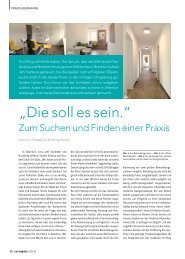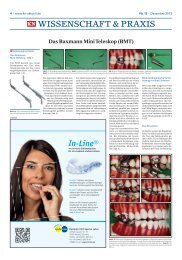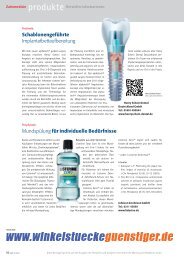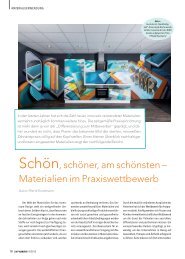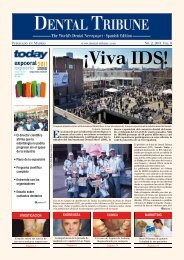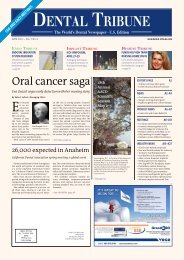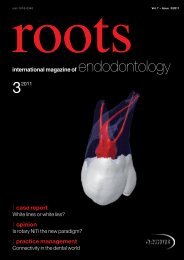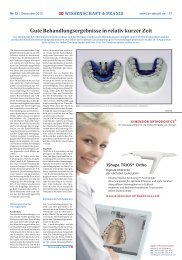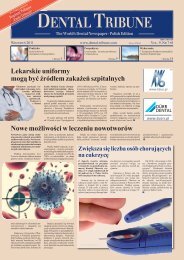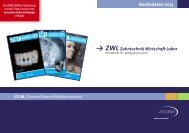Download - Oemus Media AG
Download - Oemus Media AG
Download - Oemus Media AG
Create successful ePaper yourself
Turn your PDF publications into a flip-book with our unique Google optimized e-Paper software.
DeNtal tribuNe | april-June, 2010 Product Spotlight 17<br />
Saddle stool in dentistry<br />
Veli-Jussi Jalkanen, specialist in sitting ergonomics discusses a healthy and comfortable way to sit<br />
Dental Events<br />
2010<br />
While some dental professionals<br />
have insufficient knowledge to<br />
be able to recognise or manage<br />
sitting disorders, others realise<br />
that back pain and shoulder<br />
tension have a lot to do with<br />
sitting. Poor circulation in the<br />
lower extremities; shortage of<br />
oxygen; hip, knee and shoulder<br />
joint problems; sitting fatigue,<br />
and genital health problems<br />
are some examples of the ailments<br />
that belong to the large<br />
group of SDs (Sitting Disorders).<br />
All people working in dentistry<br />
are affected by these disorders<br />
whether they are aware of them<br />
or not. Many of those who are<br />
aware of SDs would usually like<br />
to improve the situation and look<br />
for a more healthy, productive<br />
and comfortable way to work.<br />
Healthy posture for long<br />
term sitting:<br />
1. Good, relaxed posture, balanced<br />
and without harmful<br />
supports<br />
2. Thighs 90° apart and pointing<br />
down enough to keep the<br />
upper body in balance<br />
3. Close to 135° angles in hips<br />
and knees<br />
4. Weight on the sitting bones,<br />
not the muscles<br />
5. No pressure on the genitals<br />
and under the hip (especially<br />
for men)<br />
This ideal position can be<br />
obtained with a saddle stool.<br />
Sitting on a saddle stool<br />
is based…<br />
…on the sitting bones that are<br />
located under the hip. They<br />
keep the buttocks and thighs<br />
from being pressed against the<br />
seat if they have a firm support.<br />
Thighs point down at a 45<br />
degree angle, tilting the pelvis<br />
to a near neutral position, as<br />
when standing. This allows the<br />
lower back and upper body to<br />
find a relaxed, natural posture<br />
without the need for a backrest.<br />
Feet rest on the floor on both<br />
sides of the body as if you were<br />
riding a horse. This way it is easy<br />
to operate pedals with your feet -<br />
they must be placed on the side.<br />
General benefits from a<br />
saddle stool in dentistry<br />
• Good, natural and relaxed<br />
posture which also keeps improving<br />
for years<br />
• Less shoulder area tension by<br />
allowing lower positioning of<br />
the patient<br />
• Relieving or eliminating<br />
lower back pain (oftentimes<br />
it disappears in a week)<br />
• Preventing fatigue & improving<br />
productivity through<br />
deeper breathing<br />
• Preventing shoulder, hip and<br />
knee joint problems, angles<br />
are more natural<br />
• Easier movements and good<br />
working positions<br />
• Improved circulation in lower<br />
extremities prevents varicose<br />
veins + cellulite built up<br />
• Easy visibility into the mouth<br />
by leaning forward with a<br />
straight back<br />
• Working at a close distance<br />
(also the assistant) with legs<br />
under the hoisted chair<br />
• Easy rolling & turning makes<br />
picking materials fast and<br />
effortless<br />
A divided seat is helpful…<br />
… because the free space allows<br />
proper pelvis/hip position without<br />
pressure or discomfort in<br />
the soft tissues on the pubic bone.<br />
For men (who have the pubic<br />
bone much further back than<br />
women) a divided seat is a safer<br />
solution in the long run. Pressure<br />
on the pudendal nerve & tissues<br />
on the pubic bone can lead to<br />
erectile dysfunction. Loose, light<br />
and stretching trousers are highly<br />
recommended for men when<br />
sitting on any seats. With women,<br />
an additional advantage is the<br />
decreased growth of bacteria<br />
as a result of better ventilation,<br />
lower humidity and temperature<br />
in the genital area. This has a<br />
positive effect on the Footoperated<br />
height control (accessory)<br />
keeps the gloves clean & is very<br />
helpful in maintaining the welfare<br />
of your body and accuracy<br />
of your work while you change<br />
positions and sitting height in the<br />
middle of a long procedure.<br />
Shoulder joint problems…<br />
…often come from elevated<br />
shoulder positions, which stress<br />
the joints. A riding-like sitting<br />
position allows lower positioning<br />
of the patient, which allows you<br />
to relax your shoulders.<br />
Sitting down & standing<br />
up…<br />
…is easy because on a saddle<br />
stool you are half way up already.<br />
Sitting down could not be any<br />
more fluent since the backrest is<br />
never in the way. You just lift your<br />
leg over the seat from the back<br />
and sit down. This kind of mounting<br />
puts you instantly into the<br />
right kind of relaxed sitting<br />
position with good posture.<br />
Data entering…<br />
…is more fluent and time-saving<br />
when you can roll back and forth<br />
fast and easily with your saddle<br />
chair. The movements you do<br />
while using the chair keep your<br />
muscles active and improve your<br />
metabolism.<br />
The Scandinavian<br />
working concept…<br />
…is shown in the pictures. Oftentimes,<br />
both the dentist and the<br />
assistant utilise a saddle stool.<br />
Good posture, easy visibility into<br />
the patient’s mouth, efficient and<br />
free movement can all become<br />
reality. The saddle stool allows<br />
close proximity to the patient,<br />
leaving more room for the legs<br />
under the patient. This method of<br />
working dramatically decreases<br />
problems for both the dentist and<br />
the assistant, and is becoming the<br />
most common way to sit and<br />
work for dentist in Scandinavia.<br />
Adapting to a saddle<br />
chair takes some effort…<br />
…because almost everything<br />
changes. The body needs time to<br />
adjust. Learning to use the saddle<br />
chair takes a few days and the<br />
“saddle soreness” in the buttocks<br />
and inner thighs as well as<br />
fatigue of the back muscles last<br />
two-14 days.<br />
It is worth it, but…<br />
…nothing comes for free. Financially,<br />
the change is cheap. But<br />
most importantly, you need<br />
to learn about sitting physiology<br />
to be motivated to make the<br />
change, alter your working<br />
movements and positions and<br />
tolerate temporary discomfort.<br />
As a return you may achieve a<br />
healthier body, better posture,<br />
higher productivity (more<br />
patients with the same energy),<br />
improved quality of work and<br />
more satisfying years at work. DT<br />
SINODENTAL<br />
Where: Beijing (China National<br />
Convention Center)<br />
Date: 09-12 June 2010<br />
Web site: www.sinodent.com.cn<br />
1 st HONG KONG INTERNATIONAL<br />
DENTAL EXPO<br />
Where: Hong Kong<br />
Hong Kong Dental Association<br />
Date: 18-20 June 2010<br />
Web site: www.hkideas.org<br />
35 th Annual Meeting of American<br />
Academy of Esthetic Dentistry<br />
Where: Chicago, USA<br />
Date: 03-08 August 2010<br />
Web site: www.estheticacademy.org<br />
ICOI World Congress<br />
Where: Hamburg, Germany<br />
Date: 26-28 August 2010<br />
Web site: www.icoi.org<br />
FDI WORLD DENTAL CONGRESS<br />
Where: Salvador de Bahia, Brazil<br />
Date: 02-05 September 2010<br />
Web site: www.fdiworldental.org<br />
IDEM INDIA, 2010<br />
Where: Mumbai, India<br />
Date: 09-11 September 2010<br />
Web site: www.idem-india.com<br />
DENTAL EXPO<br />
Where: Moscow<br />
Dental Expo Ltd.<br />
Date: 20-23 September 2010<br />
Web site: www.dental-expo.com<br />
International Expo Dental<br />
Where: Rome, Italy<br />
Date: 07-09 October 2010<br />
Web site: www.expodental.it<br />
ADA Annual Session<br />
American Dental Association<br />
Where: Orlando, United States<br />
Date: 09-12 October 2010<br />
Web site: www.ada.org<br />
BDTA Dental Showcase<br />
Where: Excel, London<br />
Date: 14-16 October 2010<br />
Web site: www.bdta.org.uk<br />
World Dental Show<br />
Where: Mumbai, India<br />
Date: 29-31 October 2010<br />
Web site: www.wds.org.in<br />
Dentech China 2010<br />
Where: Shanghai, China<br />
Date: 02-05 November 2010<br />
Web site: www.dentech.com.cn<br />
54 th AMIC Dental Expo<br />
Where: Mexico City, Mexico<br />
Date: 03-07 November 2010<br />
Web site: www.amicdental.com.mx<br />
FAMDENT SHOW 2010<br />
Where: Hyderabad, India<br />
Date: 26-28 November 2010<br />
Email: famdentresponse@gmail.com<br />
The Great New York Dental Meeting<br />
Where: New York, USA<br />
Date: 26 Nov-01 Dec 2010<br />
Web site: www.gnydm.com DT



